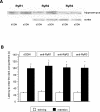Different involvement of type 1, 2, and 3 ryanodine receptors in memory processes
- PMID: 18441289
- PMCID: PMC2364603
- DOI: 10.1101/lm.929008
Different involvement of type 1, 2, and 3 ryanodine receptors in memory processes
Abstract
The administration of the ryanodine receptor (RyR) agonist 4-Cmc (0.003-9 nmol per mouse intracerebroventricularly [i.c.v.]) ameliorated memory functions, whereas the RyR antagonist ryanodine (0.0001-1 nmol per mouse i.c.v.) induced amnesia in the mouse passive avoidance test. The role of the type 1, 2, and 3 RyR isoforms in memory processes was then evaluated by inhibiting the expression of the three RyR proteins in the mouse brain. A selective knockdown of the RyR isoforms was obtained by the i.c.v. administration of antisense oligonucleotides (aODNs) complementary to the sequence of RyR1, RyR2 and RyR3 proteins, as demonstrated by immunoblotting experiments. RyR1 (5-9 nmol per mouse i.c.v.) knockdown mice did not show any memory dysfunction. Conversely, RyR2 (1-7 nmol per mouse i.c.v.) and RyR3 (1-7 nmol per mouse i.c.v.) knockdown animals showed an impairment of memory processes. This detrimental effect was temporary and reversible, disappearing 7 d after the end of the aODN treatment. At the highest effective doses, none of the compounds used impaired motor coordination, as revealed by the rota rod test, nor modified spontaneous mobility and inspection activity, as revealed by the hole-board test. In conclusion, the lack of any involvement of cerebral RyR1 was demonstrated. These findings also showed the involvement of type 2 and type 3 RyR in the modulation of memory functions identifying these cerebral RyR isoforms as critical targets underlying memory processes.
Figures







References
-
- Breuer A.C., Bond M., Atkinson M.B. Fast axonal transport is modulated by altering trans-axolemmal calcium flux. Cell Calcium. 1992;13:249–262. - PubMed
-
- Disterhoft J.F., Moyer J.R., Thompson L.T. The calcium rationale in aging and Alzheimer’s disease. Evidence from an animal model of normal aging. Ann. N. Y. Acad. Sci. 1994;747:382–406. - PubMed
Publication types
MeSH terms
Substances
LinkOut - more resources
Full Text Sources
Other Literature Sources
Medical
